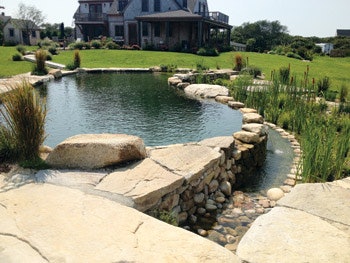
I’ve long been fascinated by the relationship between swimming pools and other types of recreational and decorative bodies of water, largely because of the way that other aquatic environments have transformed segments of our industry.
One example would be the way large water theme parks have influenced residential aquatic design. It’s no secret many residential installations now include systems once only found in waterparks, such as large interactive play structures, elaborate flume slides and even lazy rivers. (It’s not likely we’ll start seeing wave pools in backyards, but one never knows.)
On the commercial side, a great many property owners have also turned to such features to create what amount to mini-waterparks, an evolution that has led to increased attendance, profitability and functionality for many facilities. (And some of those do have wave pools.)
Fountains represent another area of integration. Growing numbers of pools these days include fountain features in the form of plumes, laminar jets and all manner of waterfalls. In fact, a handful of fountain equipment manufacturers have developed product lines aimed directly at the swimming pool market. One could argue that pools might owe the vanishing edge to fountains, and there’s no question that leaping jet deck systems come directly from the world of aquatic ornamentation.
One of the more interesting areas of crossover stems from the world of ponds and streams. The first glimmer of that hybridization came in the form of lagoon style pools; their lush plantings and rocky edges were made to look like natural bodies of water. The advent of artificial rock went on to make “naturalistic” pools affordable for middleclass pool buyers. Today, we see countless examples of custom pools that look very pond-like. Some are convincing, far more really aren’t.
On the other side of the equation, many ponds are built with swimming in mind, a trend that comes as a surprise to some. A number of pond builders I know have told me over the years that they’ve often been asked to deliberately make ponds deep enough for swimming and design them with easy point points of entry and egress. There are ponds with grottos and even some with slides, along with diving rocks and other pool-like features.
In some cases, it’s come to the point where it can be tough to draw an exact definition of what separates swimming pools and ponds made for swimming. Pools are often associated with concrete construction, while ponds are typically made with liners covered with rocks. I do think it’s safe to say the vast majority of vinyl liner pools bear little resemblance to ponds, but I’m sure there are exceptions to that assumption as well. There are also many man-made ponds built using gunite or shotcrete, so that distinction can be vague. Ponds most often have associated streams and waterfalls, but that’s also true of many pools, albeit to a lesser extent.
One place where pools and ponds have remained decidedly separate has been in the realm of water treatment. Pond craft is almost always based on the concept of using natural forms of treatment to maintain water quality, specifically in the form of bogs or constructed wetlands which act as biological filters.
In some ponds, large areas of their bottoms are fitted with under-drain manifolds that draw water through layers of gravel and sand, in effect creating sometimes-massive bio-filters. In these systems, colonies of beneficial bacteria and plant root systems consume compounds that foster the growth of algae and bacteria. It’s a necessary approach for ponds that are home to fish and aquatic plants and also preferred by both consumers and professionals who are interested in “sustainable” environments.
By stark contrast, swimming pools have long been treated with potent chemicals that oxidize organic compounds and kill microorganisms. That traditional approach has become the object of concern and even ridicule by some for a variety of reasons, but in all fairness, our industry’s approach to treatment has been, I argue, tremendously successful for close to a century.
Fact is, if done properly, both treatment scenarios lead to great water quality both in terms of clarity and bather safety, while if mismanaged can also result in unsightly, smelly water that can be harmful.
Even that seemingly un-crossable divide has been breached over the past two decades in the form of swimming pools that use biological treatment, similar to that used in many ponds, to treat water — using no manufactured chemicals of any kind. The leader in this effort is a firm called BioNova, based in Munich, Germany, that has developed what it calls “natural swimming pools” and has seen its proprietary design used to build thousands of pools across much of Europe.
The firm has garnered a fair share of press due to its unusual approach, but its novel design concept has only recently reached our North American shores. In fact, the first pool of this type built in the U.S. was finished just last summer and is the subject of a feature in this edition of AQUA Architecture, “A Natural First,” by designer and installer Jesse Dutra.
In this case, the vessel is very much a swimming pool, made of shotcrete with steps, a deep end and a vanishing edge treatment. It even has an in-floor cleaning system. Moreover, it looks like a swimming pool.
Of course, it’s highly unlikely the introduction of these pools will pose any threat to chemical manufacturers, but they do certainly offer an intriguing alternative. I leave it to Jesse to tell the story of this groundbreaking installation. For my part, I urge you to consider the implications of this revolutionary, and yet completely old-fashioned approach to water treatment.
Comments or thoughts on this article? Please e-mail [email protected].












































